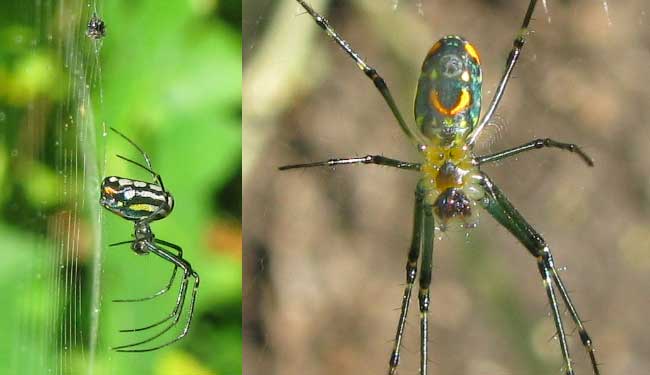Excerpts from Jim Conrad's
Naturalist Newsletter

from the November 14, 2010 Newsletter issued from Hacienda Chichen Resort beside Chichén Itzá Ruins, central Yucatán, MÉXICO; limestone bedrock, elevation ~39m (~128ft), ~N20.676°, ~W88.569°
ORCHARD WEAVER
For the last month or so the top branches of many tall weeds and bushes in and around the Hacienda have borne horizontally deployed orb webs two feet or so across (60 cm). The spider hangs upside down beneath the webs' spiraling threads. Two shots of one of these spiders, the image on the left displayed vertically instead of its original horizontal position, are shown above.
We have lots of fascinating spider species here that I never mention because I can't identify them and therefore can't find out what's interesting about them. However, this species is so ubiquitous that I hoped it might occur in southern Florida, in which case someone at a spider forum might recognize it. Having enjoyed such success with the German ant forum, I searched for an active spider forum and came up with "Arachnoboards," sponsored by the British Tarantula Society, at http://www.arachnoboards.com.
Two days after posting my picture I was astonished to find that several people -- one in Rome, Italy, two in Florida, and one each in Maryland, Louisiana and Michigan, had left comments. The spider is the Venusta Orchard Weaver, LEUCAUGE VENUSTA, a long-jawed orbweaver distributed from southern Canada to Panama, along the eastern US coast, extending into the central US.
Forum user "davisfam" in central Florida, who calls young spiders "spidiies," wrote:
Leucauge venusta is extremely abundant during the rainy season in coffee plantations in Chiapas State and other areas of Mexico. The web of this species is made in semi-open sites generally between weeds or between adjacent bushes. Young L. venusta spidiies build webs close to the ground, but as sexual development proceeds, the specimen increases the height at which the web is built. The sexual maturity of females induces migration to places where prey is more abundant. It's quite possible that immature spidiies are abundant right now along with the adult specimens. No worries, these beautiful spidiies are harmless and extremely docile... just pretty to look at and take pictures of!
Another user in Florida added that "The neon yellow, orange or red spots on the rear of the abdomen are variable in size among individuals and sometimes absent."
And "This species is parasitized by a wasp larva which attaches itself externally at the junction of the cephalothorax and abdomen."
So, again, how about that for the power of the Internet? Already just by noon on the Wednesday I visited Arachnoboards, 599 visits had been registered at the forum. That's a lot of people interested in arachnids on a Wednesday morning!